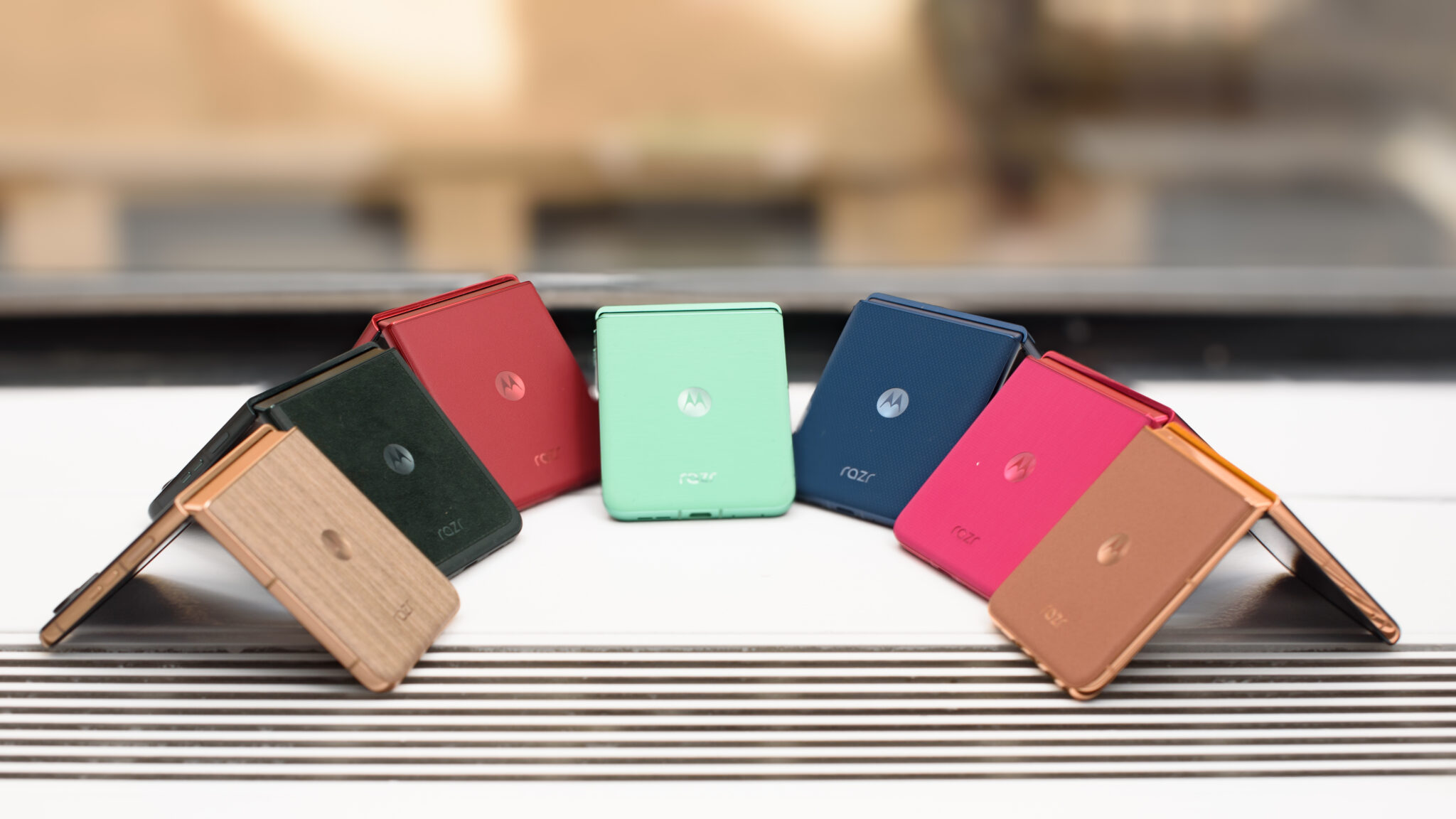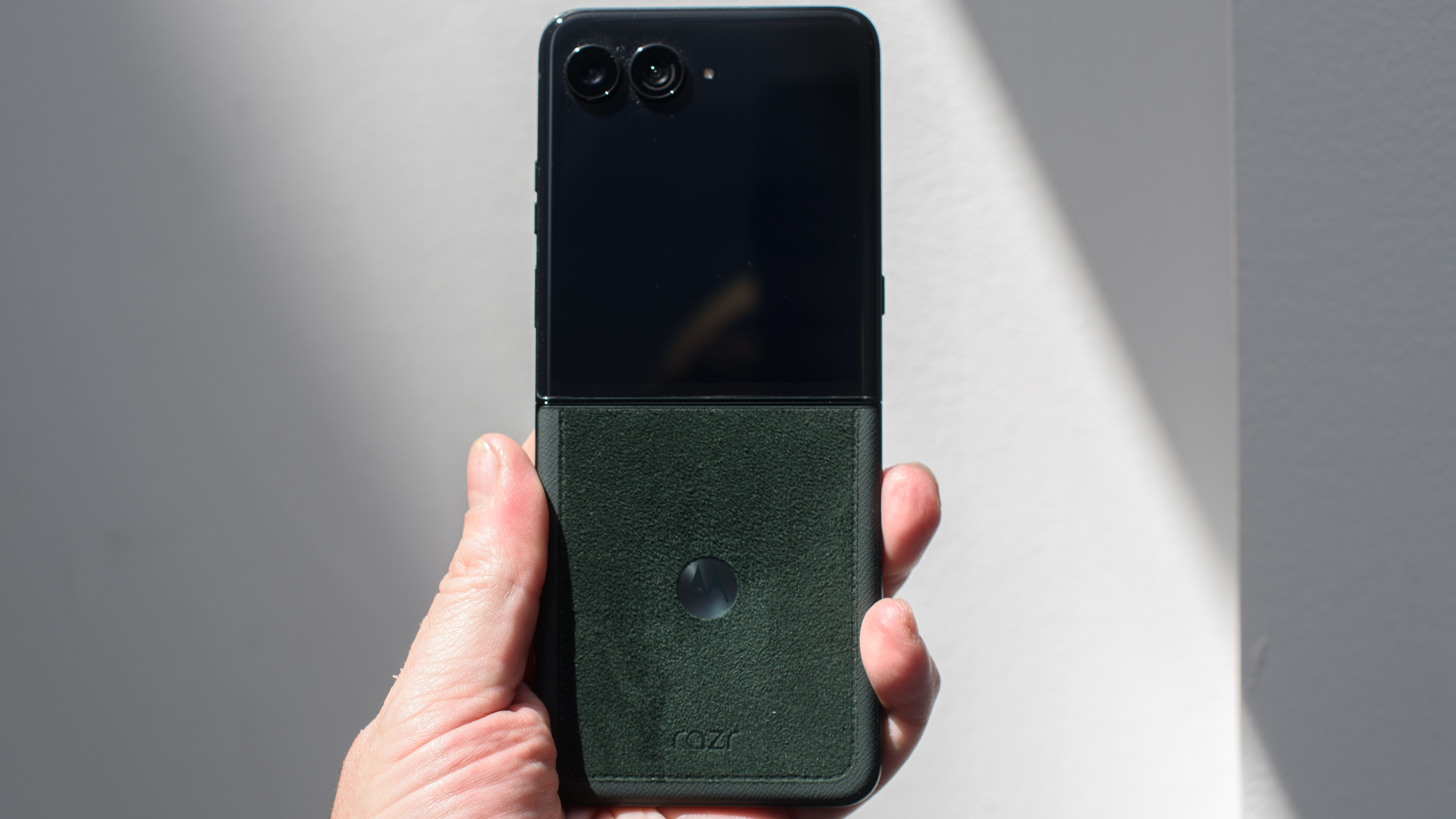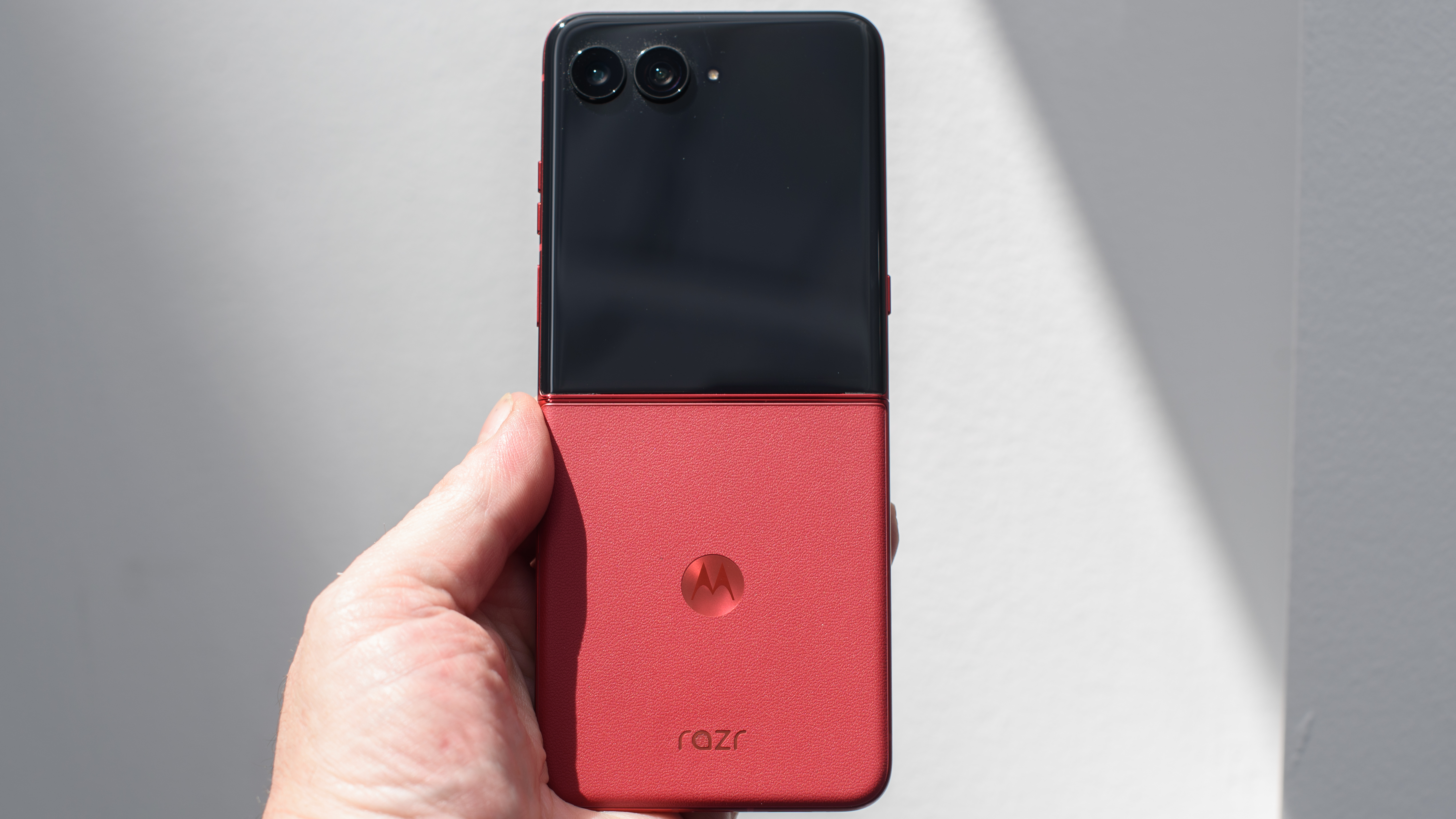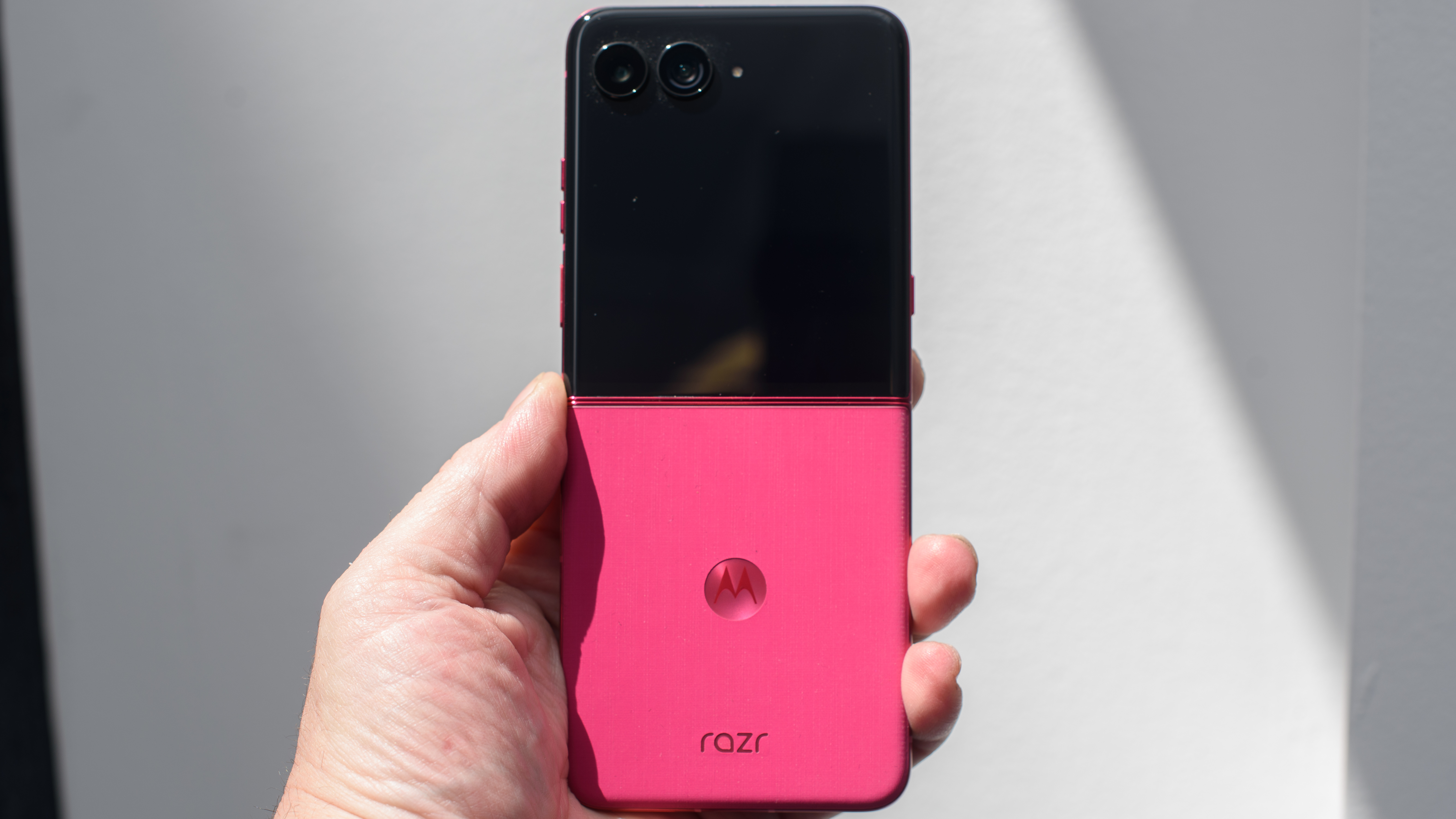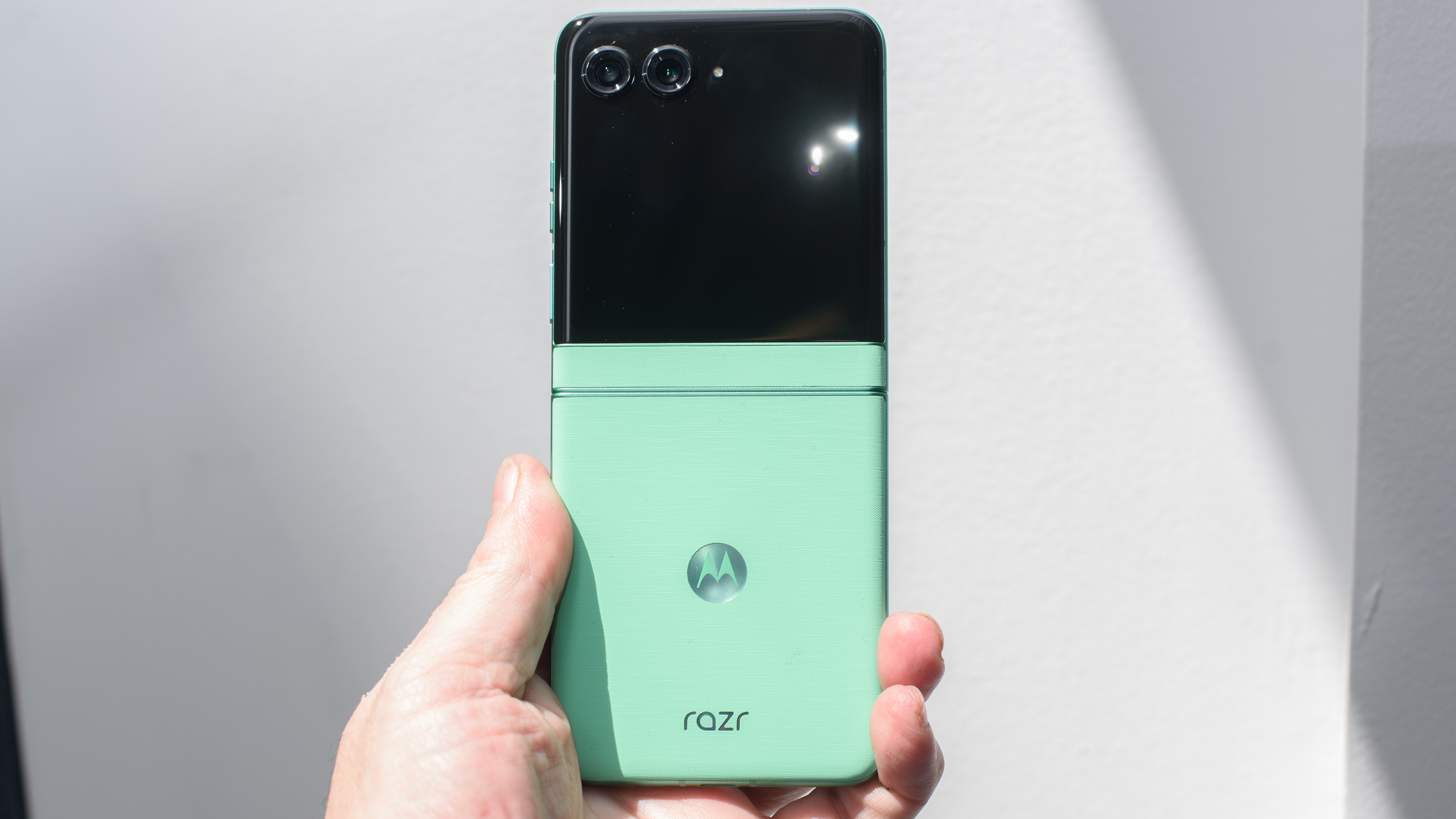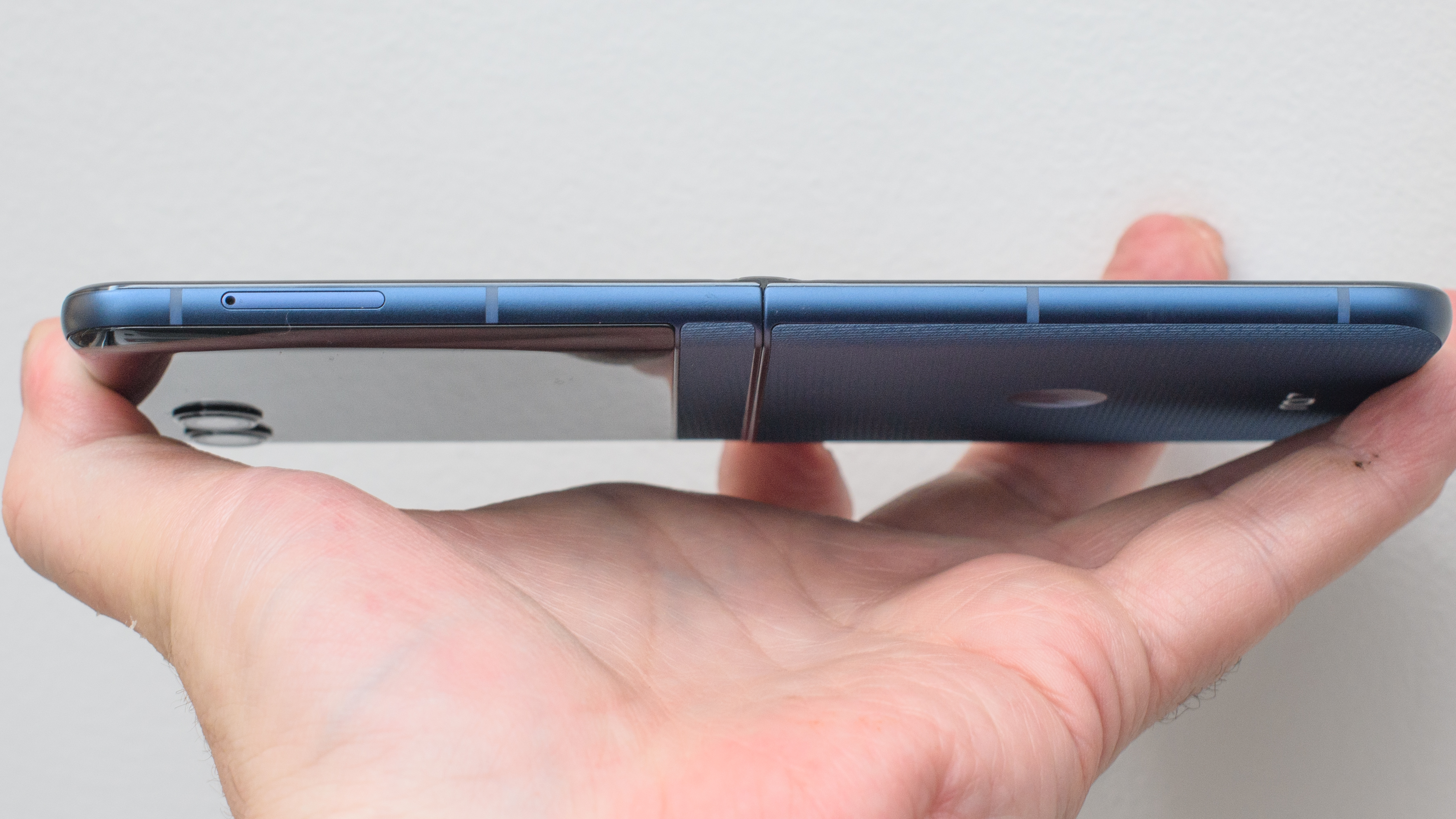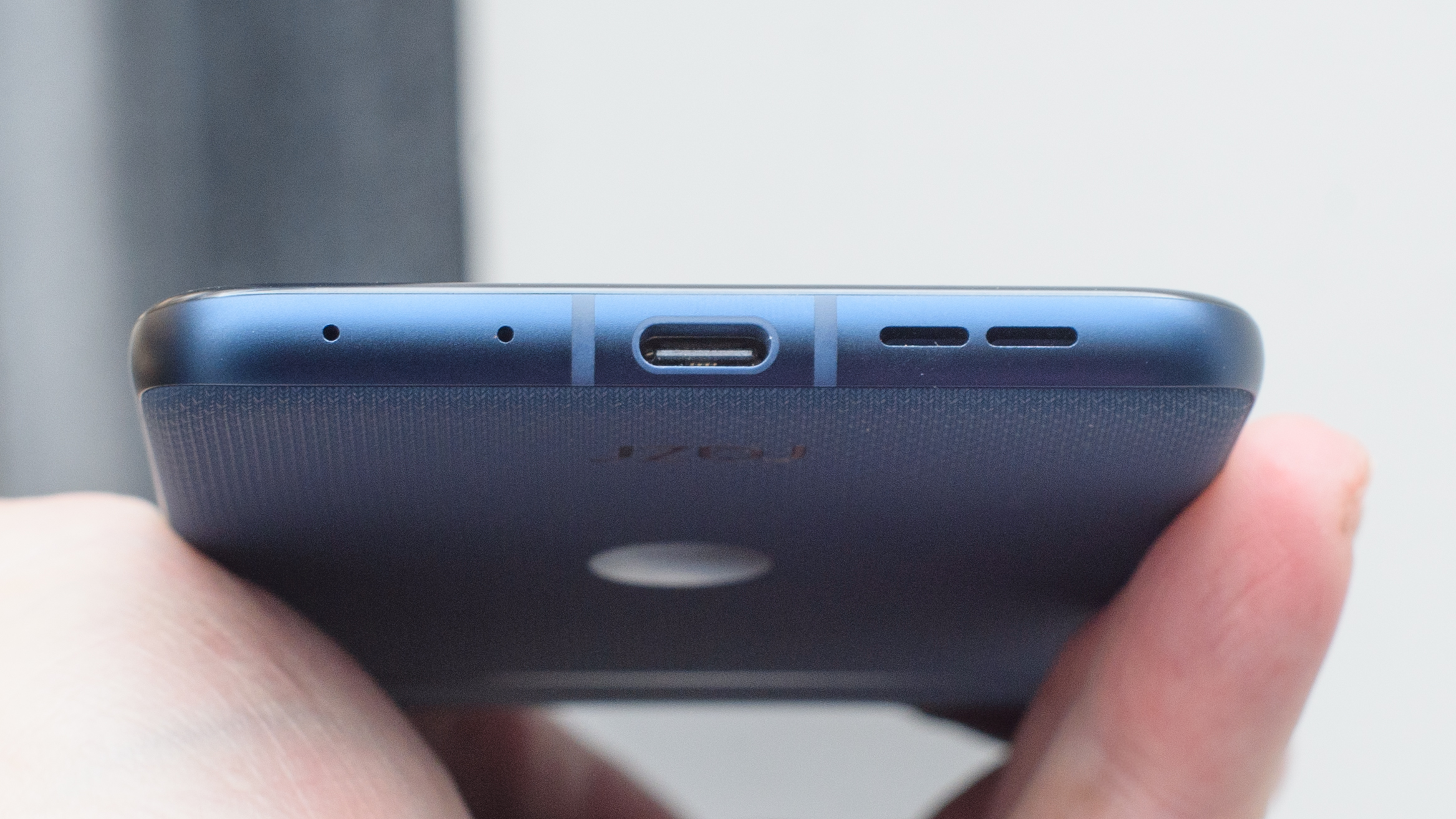Why you can trust TechRadar
We spend hours testing every product or service we review, so you can be sure you’re buying the best. Find out more about how we test.
With the Motorola Razr Ultra 2025, Motorola emphatically wants you to judge its book by the cover. If the Moto Razr stood out before with its unique colors, this year’s Razr, Razr Plus, and Razr Ultra phones cry out for attention with the most unique materials I’ve ever seen on a phone lineup.
The Motorola Razr Ultra 2025, a new high-end for the Razr family that doesn’t compromise on performance, durability, or design materials, is launching on May 15, with pre-orders starting May 7. It uses materials like real wood and Italian Alcantara, a suede-like synthetic fabric, in addition to the familiar vegan leather finish that I’ve enjoyed on past Razr phones. The cheaper Motorola Razr 2025 will feature a textured nylon-like finish, as well as a more sturdy acetone.
Is it weird that I’m starting my hands-on review of the new Motorola Razr Ultra by talking about the materials? It’s even more weird that Motorola didn’t talk about the materials to start its Razr launch event. It didn’t talk about design, or durability, or performance. It didn’t mention the new titanium hinge until the very end, and the impressive new Snapdragon 8 Elite processor was an afterthought.
The time I went to a phone launch and they forgot to launch the phones
Motorola launched the Motorola Razr 2025 family by talking about, yes, AI – cue a collective groan. Moto spent an hour slogging through AI features – the same features, incidentally, that Apple is getting in trouble for failing to launch. Features that let the phone gather a wealth of information about you, and what you are doing at any given moment, to remember and recite later in response to your questions.
I seriously thought Motorola had forgotten about its new phones as it paraded partners and executives on stage to talk about partnerships and executions. The partnerships executive for Pantone appeared (in a taped video) to talk about working with Motorola. Not Pantone’s color chief, or creative executives. The business-partners guy.
Just as my cynicism was building, Motorola marched Perplexity AI CEO Aravind Srinivas on stage, looking nervous and amateurish, to talk about the way Motorola will be integrating and offering more Perplexity features on upcoming phones. Buyers will get a few months of free service to use what our friends at Wired called “a Bullsh*t Machine,” an AI that has been proven to plagiarize journalists’ work.
Fine, Motorola – if you’re not going to talk about your new phones until the end of the presentation, I’ll do the same. I loved last year’s Motorola Razr Plus 2024… until I got to the AI features. I found an AI image generator that created images that fell into bigoted stereotypes. It was the first image generator on a phone that allowed bigoted stereotypes of humans – a real milestone.
Further, most of the AI features Motorola promised at the Razr Plus 2024 launch never materialized. The phone was supposed to be able to listen to your calls, and even pay attention to your conversations in person, to take notes and relay answers later. Those features are still unavailable.
By the time this new Motorola Razr Ultra 2025 launches, the AI features Moto promised back in 2024 might be offered to beta software testers, at best. But that isn’t keeping Motorola from claiming that the new phone will be able to do all of the same things the old phone was never able to manage.
This is very sad, because Motorola may have created its best foldable phone ever – a phone that finally rivals flagship foldables from Samsung like the Galaxy Z Flip 6. Instead of focusing on the phone, though, Motorola is trumpeting Moto AI, but smartphone AI has proven to be a less-than-worthless feature so far, perhaps even doing more harm than good.
Through the end of the two-hour launch event, Motorola never said the complete name of the new device – the Motorola Razr Ultra – even one time. There was no discussion of pricing or availability until we got a fact sheet sent over email later in the day. It felt like Motorola was so excited to talk about its new partnerships with Perplexity and Swarovski, among others, that it forgot to mention the new phones.
Actually, there were new Motorola RAZR phones, and they spoke for themselves
Enough with the AI; onto the new phones! With the 2025 Motorola Razr family, Motorola leans even harder into the idea that you should absolutely judge a book by its cover. And honestly, what covers these are.
The Razr Ultra 2025 isn’t just a phone; it’s a statement piece, a fashion accessory that happens to make calls, take photos, and pack some serious performance under the hood.
The partnership with Pantone, which gave us past year’s Peach Fuzz and Mocha Mousse, reaches new heights. Every colorway for the new Ultra feels deliberate, curated, and tied to a specific material choice that elevates the phone beyond simple plastic and Gorilla Glass.
This year, the Razr Ultra (2025) comes in colors that include Pantone Rio Red, Scarab, Mountain Trail, and Cabaret. The Razr (2025) is available in colors that include Pantone Spring Bud, Gibraltar Sea, Parfait Pink, and Lightest Sky. While the Pantone names are evocative, the materials are the real story.
Motorola is bringing back wood! Yes, actual wood graces the Mountain Trail variant, a fantastic and welcome throwback to the days of the customizable Moto X. Holding it evokes a warmth and organic texture that’s missing from the cold metals and glass dominating the market. It felt premium, unique, and surprisingly durable during my initial hands-on time. I hope it weathers nicely after a few years of use.
Then there’s the Alcantara finish, which adorns the Pantone Scarab model. This soft, suede-like material feels fantastic – grippy, luxurious, and resistant to fingerprints. It adds a tactile dimension that’s genuinely pleasant, and reminds me of driving my Porsche – the one I don’t actually own – through the countryside.
My only slight reservation here is the Scarab color itself; while sophisticated, it feels a bit… ominous compared to the vibrancy Moto usually brings. It’s a muted, dark greenish-grey that might appeal to those wanting subtlety, but it feels like a missed opportunity compared to the potential vibrancy Alcantara can hold. I would have liked to see a light-blue Alcantara, or a Mocha Mousse version.
The Rio Red and Cabaret options, paired with vegan leather, promise the more eye-catching hues we’ve come to expect. I was surprised that Motorola is offering two reddish hues on the same model, but they clearly know more about colors than I do.
Motorola is clearly banking on design diversity, offering something that stands out in a sea of smartphone sameness. But as I noted last year with vegan leather, material choices have implications. Wood requires careful sourcing, and Alcantara, while luxurious, is still a synthetic material. The eco-conscious narrative is complex, and today’s economic climate is not making eco-friendly choices more profitable.
The Motorola Razr Ultra (2025) – finally a true Razr flagship phone
Beneath the surface, has the Ultra moniker been earned? Let’s delve into the hardware, because there are significant changes inside, potentially addressing my lingering hesitations from previous generations.
The new Motorola Razr Ultra 2025 gives the Razr family a high-end model that matches the competition. Motorola used to sell the same phone as the Razr Plus in the US and the Razr Ultra in the rest of the world. This year, these are distinct models.
The Razr Plus 2025 is very similar to last year’s Razr Plus 2024 and Razr 50 Ultra, but the new Razr Ultra 2025 – that’s Razr 60 Ultra for most of the world – is a whole new beast.
It’s also an expensive beast, sadly. Last year’s Motorola Razr Plus / Razr 50 Ultra cost $999.99 / £999.99 / AU$1,699, and Motorola perpetually offered a $300 discount for that phone, at least in the US, making it one of the most affordable phones you can buy, foldable or not.
This year’s Motorola Razr Ultra 2025 starts at a whopping $1,299 (UK and AU pricing was TBC at publication time). That’s more than a Samsung Galaxy Z Flip 6 and more than an iPhone 16 Pro Max. It’s the same price as Samsung’s Galaxy S25 Ultra, the most feature-packed phone you can buy (that doesn’t fold in half).
Thankfully, the Moto Razr Ultra 2025 works to earn that price bump. While the Snapdragon 8s Gen 3 in last year’s Razr Plus was capable, it wasn’t a true, top-tier flagship chip. The Razr Ultra 2025 rectifies this emphatically by incorporating the Snapdragon 8 Elite mobile platform. I’ve been very impressed by the Snapdragon 8 Elite phones I’ve tested so far this year, especially the OnePlus 13. The new chipset offers top-notch performance and superlative battery life.
The new Motorola Razr Ultra 2025 also comes with a substantial boost in memory and storage – now starting at a whopping 16GB of LPDDR5X RAM and 512GB of UFS 4.0 storage (with a 1TB option available). This phone should feel instantly faster, and I’m expecting it will be significantly more future-proof. Last year’s 8GB/256GB starter configuration of the Moto Razr Plus 2024 feels almost quaint by comparison.
Motorola Razr Ultra (2025) hands-on review: Display
Motorola also continues its winning streak on flip phone displays. The external cover display, already a standout feature, retains its vibrancy and gets a boost to a peak brightness of 3,000 nits. It remains the most usable and versatile cover screen on any flip phone, bar none.
Moto’s philosophy of allowing most Android apps to run natively on this outer screen is still its killer app, making quick interactions genuinely useful without you needing to open the phone. Enhancements for apps like Google Photos and Spotify were welcome last year, and I expect further refinements here. Sadly, the only app Motorola demonstrated on the cover display was the new Perplexity AI app.
Unfold the Motorola Razr Ultra 2025 and you’re greeted by a gorgeous 7.0-inch AMOLED panel (6.9-inches on the Razr and Razr Plus). It’s an HDR10+ certified, Dolby Vision-capable screen with a sharp 464ppi pixel density. Like the cover screen, it boasts an adaptive LTPO refresh rate up to 165Hz and pushes brightness even further to a dazzling 4500 nits peak, though we’ll have to test those claims in Future Labs before we confirm their accuracy.
Motorola Razr Ultra (2025) hands-on review: Cameras
Now, let’s talk about the Achilles’ heel of foldable phones like the previous Razr Plus: the cameras. Foldables inherently struggle here due to space constraints. Last year’s jump to 50MP on the Plus sounded good, but came with smaller individual pixels, relying on pixel binning. I was hopeful, but ultimately found the results good, not great. This year, the Razr Ultra seems to be taking the camera situation much more seriously, with upgrades across the board.
The main camera is still a 50MP sensor, but the specs suggest a significant improvement. It uses quad pixel-binning technology to produce 12.6MP images, but the effective pixel size resulting from this binning is now a much larger 2.0μm (up from 1.6μm effective last year, which itself was binned from 0.8μm native pixels on the sensor).
This, combined with an f/1.8 aperture, OIS, and instant all-pixel PDAF, could translate to much better low-light performance and overall image quality. Motorola is also touting Pantone Validated Color and Skin Tones. This is a new development for Pantone, so we’ll have to test the Razr cameras to see if they deliver on this promise.
Instead of last year’s 2x zoom on the Plus, the Ultra brings back a dedicated 50MP ultrawide camera with a 122-degree field of view. This sensor also uses Quad Pixel binning for 12.6MP shots with an effective 1.2μm pixel size, and it doubles as a macro camera.
While I appreciated the utility of the 2x zoom for portraits last year, a high-resolution ultra-wide often proves more versatility for landscapes, group shots, and creative perspectives. The macro capability is a nice bonus, if Motorola can match the macro performance we’re seeing from the best camera phones.
Even the front-facing (internal) camera gets a massive bump to 50MP, again using pixel-binning technology for 12.6MP images with a 1.28μm effective pixel size and an f/2.0 aperture. This is a huge step up, and promises much better selfies and video calls when the phone is open.
On paper, this camera system looks like the upgrade I was hoping to see. It genuinely seems that Motorola has invested in larger, better sensors across the board, and larger sensors are the best upgrade for a new camera.
Of course, the proof of the pudding is in the eating, and extensive testing will be needed to see if the processing and software can truly leverage this hardware potential and finally make the Razr camera competitive with the best camera phones from Samsung, Google and OnePlus. My fingers are crossed.
Motorola Razr Ultra (2025) hands-on review: Battery life
Battery life and charging get a significant boost on the new Motorola Razr Ultra – a nice turn, since this is often a compromise on thin foldables. The 2025 Razr Ultra packs a much larger 4,700 mAh battery, a substantial increase from the 4,000 mAh cell in the Razr Plus 2024. Along with the efficient Qualcomm Snapdragon 8 Elite chipset inside, this should make a noticeable difference in daily endurance.
When it does need topping up, charging speeds have also dramatically increased. We now get 68W wired charging (up from 45W, though the charger is sold separately) and faster 30W wireless charging (doubling last year’s 15W). There’s even 5W reverse wireless charging to juice up earbuds or other accessories. This comprehensive power upgrade addresses a key user concern and adds significant practical value for the new, more expensive Razr Ultra.
Motorola Razr Ultra (2025) hands-on review: Durability and design
Perhaps most importantly, the new Razr family will be more durable than ever before. The Razr Ultra 2025 boasts an IP48 rating. The ‘8’ signifies the same strong water resistance as before (up to 1.5 meters for 30 minutes in fresh water).
The ‘4’, however, is new to Razr and crucial. It indicates protection against solid objects larger than 1mm. This means better defense against things like crumbs, pocket lint, or grit getting into the hinge mechanism – a common worry for foldable owners.
It’s not full dust proofing (like an IP68 rating on a traditional phone), a limitation it shares with competitors like the Samsung Galaxy Z Flip 6, but it’s a welcome step towards greater peace of mind for everyday use.
All these upgrades – the bigger battery, potentially larger camera modules, improved hinge protection, premium materials like wood – come with another slight cost: weight. The Razr Ultra 2025 tips the scales at 199g. That’s roughly 10g heavier than last year’s Motorola Razr Plus 2024, and this new Razr Ultra is the heaviest flip phone currently on the market.
However, let’s keep perspective. It’s still remarkably pocketable when closed, and it’s significantly lighter than many traditional flagship slabs. For context, the Motorola Razr Ultra is about an ounce (around 28g) lighter than the iPhone 16 Pro Max, despite offering a similar main display size and battery cell. In my brief handling, the extra weight wasn’t bothersome and even added to the premium, dense feel.
Motorola Razr Ultra (2025) hands-on review: Software
Running Android 15 out of the box, the software experience felt typically Moto – clean, fluid, with useful additions rather than heavy-handed skinning. The powerful Snapdragon 8 Elite chip ensures everything flies. Regarding AI, the conversation feels similar to last year. Google’s Gemini is likely deeply integrated, benefiting from the NPU on the new chipset for faster on-device processing.
Moto’s own Moto AI features, like the intriguing “Pay Attention” recording/summarization tool previewed last year, remain something I’m waiting to see fully realized. I can keep waiting, but Moto needs to demonstrate a clear, reliable, and secure AI strategy soon.
The hardware is now undoubtedly capable; the software execution remains the question mark, much like last year. I also sincerely hope Motorola improves its track record on major Android version updates, which lagged significantly for the 2023 models.
Motorola Razr Ultra (2025) hands-on review: Not the final verdict
So, has the Motorola Razr Ultra 2025 earned its “Ultra” suffix? Based on this initial hands-on, I’d say yes. Motorola has not only doubled down on its flip-phone design leadership with exciting materials like real wood and Italian Alcantara and refined color partnerships, but it has also decisively addressed key hardware shortcomings.
The move to a true flagship processor, the doubled RAM/storage, the significantly larger battery with faster charging, and the promising, across-the-board camera sensor upgrades represent a major leap forward. The improved IP rating adds practical durability.
While I can’t deliver a final verdict until I’ve had time to test this phone with a full review – especially focusing on camera performance and real-world battery endurance – the Razr Ultra 2025 feels like the most complete, comely, and compelling Razr yet.
If the high price has you flummoxed, just wait. As we saw last year, Motorola’s list prices are often just a starting point. Keep a close eye out for carrier deals, trade-in offers, and big discounts soon after launch – patience might save you a significant chunk of change. If you’re too excited to wait, the hardware upgrades might make paying full price feel more justified, especially if those cameras finally deliver.
…
Read the full article here





